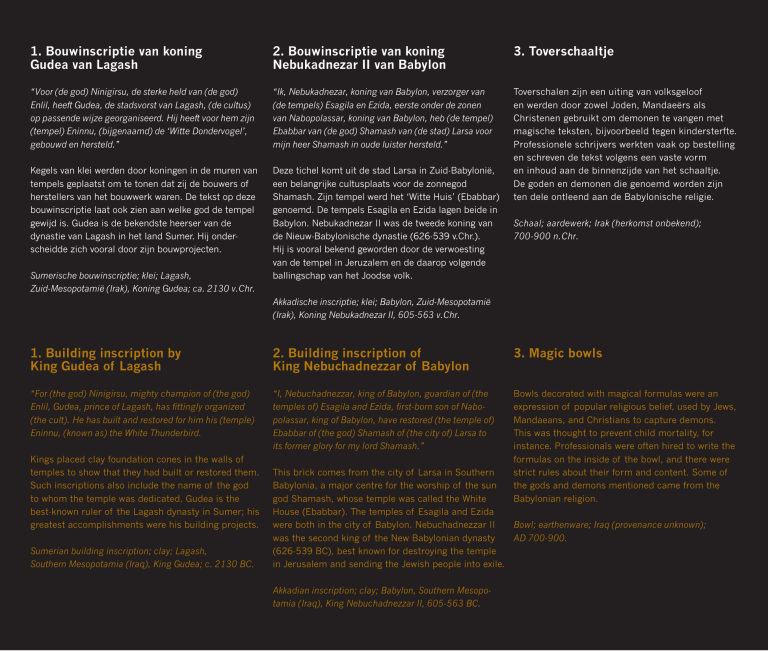
1. Bouwinscriptie van koning
Gudea van Lagash
2. Bouwinscriptie van koning
Nebukadnezar II van Babylon
3. Toverschaaltje
“Voor (de god) Ninigirsu, de sterke held van (de god)
Enlil, heeft Gudea, de stadsvorst van Lagash, (de cultus)
op passende wijze georganiseerd. Hij heeft voor hem zijn
(tempel) Eninnu, (bijgenaamd) de ‘Witte Dondervogel’,
gebouwd en hersteld.”
“Ik, Nebukadnezar, koning van Babylon, verzorger van
(de tempels) Esagila en Ezida, eerste onder de zonen
van Nabopolassar, koning van Babylon, heb (de tempel)
Ebabbar van (de god) Shamash van (de stad) Larsa voor
mijn heer Shamash in oude luister hersteld.”
Kegels van klei werden door koningen in de muren van
tempels geplaatst om te tonen dat zij de bouwers of
herstellers van het bouwwerk waren. De tekst op deze
bouwinscriptie laat ook zien aan welke god de tempel
gewijd is. Gudea is de bekendste heerser van de
dynastie van Lagash in het land Sumer. Hij onderscheidde zich vooral door zijn bouwprojecten.
Deze tichel komt uit de stad Larsa in Zuid-Babylonië,
een belangrijke cultusplaats voor de zonnegod
Shamash. Zijn tempel werd het ‘Witte Huis’ (Ebabbar)
genoemd. De tempels Esagila en Ezida lagen beide in
Babylon. Nebukadnezar II was de tweede koning van
de Nieuw-Babylonische dynastie (626-539 v.Chr.).
Hij is vooral bekend geworden door de verwoesting
van de tempel in Jeruzalem en de daarop volgende
ballingschap van het Joodse volk.
Toverschalen zijn een uiting van volksgeloof
en werden door zowel Joden, Mandaeërs als
Christenen gebruikt om demonen te vangen met
magische teksten, bijvoorbeeld tegen kindersterfte.
Professionele schrijvers werkten vaak op bestelling
en schreven de tekst volgens een vaste vorm
en inhoud aan de binnenzijde van het schaaltje.
De goden en demonen die genoemd worden zijn
ten dele ontleend aan de Babylonische religie.
Sumerische bouwinscriptie; klei; Lagash,
Zuid-Mesopotamië (Irak), Koning Gudea; ca. 2130 v.Chr.
Schaal; aardewerk; Irak (herkomst onbekend);
700-900 n.Chr.
Akkadische inscriptie; klei; Babylon, Zuid-Mesopotamië
(Irak), Koning Nebukadnezar II, 605-563 v.Chr.
1. Building inscription by
King Gudea of Lagash
2. Building inscription of
King Nebuchadnezzar of Babylon
3. Magic bowls
“For (the god) Ninigirsu, mighty champion of (the god)
Enlil, Gudea, prince of Lagash, has fittingly organized
(the cult). He has built and restored for him his (temple)
Eninnu, (known as) the White Thunderbird.
“I, Nebuchadnezzar, king of Babylon, guardian of (the
temples of) Esagila and Ezida, first-born son of Nabopolassar, king of Babylon, have restored (the temple of)
Ebabbar of (the god) Shamash of (the city of) Larsa to
its former glory for my lord Shamash.”
Bowls decorated with magical formulas were an
expression of popular religious belief, used by Jews,
Mandaeans, and Christians to capture demons.
This was thought to prevent child mortality, for
instance. Professionals were often hired to write the
formulas on the inside of the bowl, and there were
strict rules about their form and content. Some of
the gods and demons mentioned came from the
Babylonian religion.
Kings placed clay foundation cones in the walls of
temples to show that they had built or restored them.
Such inscriptions also include the name of the god
to whom the temple was dedicated. Gudea is the
best-known ruler of the Lagash dynasty in Sumer; his
greatest accomplishments were his building projects.
Sumerian building inscription; clay; Lagash,
Southern Mesopotamia (Iraq), King Gudea; c. 2130 BC.
This brick comes from the city of Larsa in Southern
Babylonia, a major centre for the worship of the sun
god Shamash, whose temple was called the White
House (Ebabbar). The temples of Esagila and Ezida
were both in the city of Babylon. Nebuchadnezzar II
Bowl; earthenware; Iraq (provenance unknown);
was the second king of the New Babylonian dynasty
AD 700-900.
(626-539 BC), best known for destroying the temple
in Jerusalem and sending the Jewish people into exile.
Akkadian inscription; clay; Babylon, Southern Mesopotamia (Iraq), King Nebuchadnezzar II, 605-563 BC.











